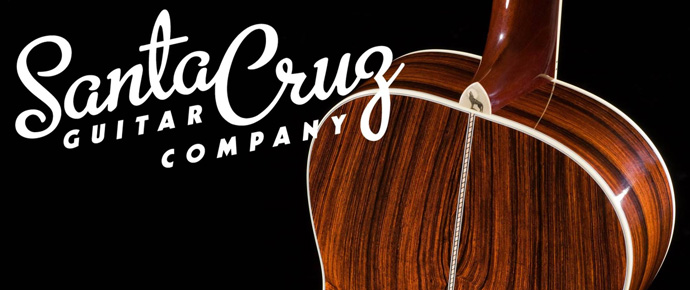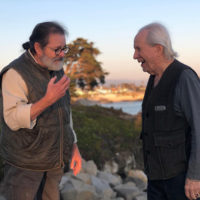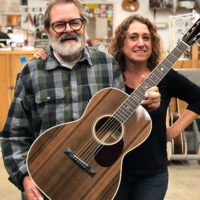
By any measure, Richard Hoover has an extraordinary story to tell. Santa Cruz Guitar Company (SCGC), which he founded, has been building world-class guitars for world-class players such as Tony Rice, Chris Hillman, Vince Herman, Trey Hensley, David Grier, and Eric Clapton for over forty years, and they are at the forefront of the open-source lutherie and sustainable guitar building movements.
A couple of years back I spoke with Richard after attending one of his free shop tours in Santa Cruz and published the following interview in the California Bluegrass Association (CBA) monthly Breakdown publication. Enjoy.
Hi Richard. You’ve been an active supporter and “Official Guitar of the CBA Father’s Day Festival” for quite some time. We thank you very much.
Yes, we’ve donated guitars and other instruments over the years for raffles and such. I’m from the Central Valley, so I’m very familiar with the festival and audience. I’m honored to help out.
We just finished your wonderful (and free) shop tour. What is open source lutherie?
It means not keeping secrets; people share freely about what they’ve learned.
Why is that important?
The whole process of guitar making has improved, and people enjoy better instruments because we’re talking to one another.
Talk about sustainability in the guitar making process and specifically using old wood and not illegally harvest materials from protected forests.
Guitar making is a very cool thing to do, but it’s only a vehicle like any other job. It’s also a good livelihood, but our real goal is peace of mind and quality of life. We want to be dealing with customers and vendors who are like-minded and fulfilling to hang out with. People don’t go into sustainability practices for profit; the benefit is that the wood sounds better, so we’re able to make better sounding guitars. The resins in the wood have been polymerized and thus more resonant, so they sound better.
Can you share some of those interesting stories about procuring the old wood?
There are a million stories. We have mahogany here that came from a ship that was scuttled off of New Orleans in 1890 where the crew abandoned it from an impending storm. The storm didn’t come, but later people came and took all of the wood off of the boat, that somehow ended up in a barn in Louisiana where it eventually made its way to us.
The backs and sides of the guitars we built for our 40th anniversary were made of oak that a friend from the Czech Republic gifted to us, and was buried in a sand mine. It was later carbon dated at being 8,000 years old. The wood looked spooky, kind of blue grey. That was 2,000 years before the first written word, so that’s old. The question is how did it get under sand quick enough without oxygen in order to be preserved? That’s a nice puzzle.
There’s some old wood from a little closer home, isn’t there?
In the Seattle area they were rerouting a stream to put an easement between two properties, and they found a cedar tree under the stream. In Santa Cruz, there was a dig across the street from the Catalyst for a parking garage where they found a sycamore tree 30 feet down. The geologist said it was from up the San Lorenzo River, which hasn’t run down Pacific Avenue in a couple thousand years. The old reclaimed wood is a great story, and after 40 years of us telling this story, the wood just seems to finds us. I hope your article does the same thing and connects us with some old wood.
What does your current backlog look like?
Well we do it kind of different. Every guitar we build is for a specific person or a shop, and we don’t swell or shrink depending on market demand. We make the best guitar we can with the right amount of people so our production is very predictable. We divide that inventory up with the stores that we do business with and let them commit to a certain number of guitars per year, and we save those positions on our build calendar for them.
Are other builders are different?
Martin and Taylor will build as many guitars as they can basically for the market demands. They create an inventory; people order, and they fill the orders as fast as they can. When the market is crummy, they’ll cut back and make and store fewer guitars, so it’s pretty much just in time delivery. We can’t shrink and swell like that because our guitar makers require a lot of experience and training. We don’t have the luxury to have transient labor you can train really quickly to meet that demand.
How many employees do you have?
We’re always around sixteen builders, but we may have extras say if someone is leaving and the new person has to be trained. There are three people in the office doing sales, marketing, and bookkeeping, plus three dogs and me.
Is that number pretty stable?
Yes, it’s been stable since around 2000.
So you didn’t lay anyone off in 2008?
No, the only time we had to do that was in 2002, and that also was a remarkable recession and we were just overextended. At that time we had around 20 guitar builders and people just stopped buying guitars. We had an inventory that we just couldn’t afford and if we kept everyone, we’d just run out of cash and we couldn’t pay anybody. Many of those people were able to come back later.
That’s remarkable.
We learned from that, and I promised I would never ever try to grow the business like that again. This is the right size; I know all the people and we all enjoy a good quality of life, so there’s no reason to go beyond where we are now. We focus on being more efficient – not to increase profits but to make better guitars. We’re at a sweet spot right now and I don’t want to wreck it.
It seems like everybody that works here is a picker.
Yea, pretty much. It’s not required, it just happens.
How do you consistently make great sounding guitars?
Well to make a lot of guitars, you have to make and assemble them efficiently to keep the cost down. To do that, you have to make them accurate sizes. Wood is so different that each piece of wood is going to resonate at different frequencies, so if you build your guitar out of pre-size pieces, the frequencies are random and it’s like throwing rocks at a piano. The factory-built instrument is going to be loud, but only by chance will it be beautiful sounding because it’s in harmony and sustains and develops overtones.
Is this what you called tuning the wood in the instrument?
Yes, in the master violin style, which we practice, we actually build the components to a frequency or a note rather than a dimension, and we assemble the instrument like a chord on a piano. When it’s played and put into motion from the string energy, the wood is in tune; it sustains and develops overtones, so we get the “good” one every time. My friend who’s responsible for selling one million guitars a year says that the secret to selling a million steel string guitars is to make them loud enough that marketing will take care of the rest. Most people really haven’t heard a truly sophisticated sounding instrument. It’s not a boast or marketing copy; we just take the time to do it based on the violin masters’ secrets.
You do use machines though, right?
Of course, but we never compromise the quality of the instrument to make it faster or cheaper to build. The machines are doing things repetitively that don’t require artistry or judgment or a person’s gifted hands. A machine can do these things and the person with the gift of artistry can do the important stuff that doesn’t require that. I could write a book on that, it’s kind of hard to explain. Machines are not the difference between the good guitar and the bad guitar; it’s where you use your hands that make it a good guitar.
That also speaks to the sustainability of the guitar builders, doesn’t it?
Absolutely, because they’re not going to get all used up here. We’re not going to use their wrists to make a profit at the expense of the loss of their ability to practice their art. That sounds like something out of child labor days but it goes on every day, where people profit off of the workers’ loss of their ability to work. Our use of machinery is to allow the builders to practice their artistry.
What about your work makes you really proud?
Well when we sell a guitar to a celebrity, it’s fun. But what truly satisfies me is to make guitars that somebody takes out in the world as a tool and changes the world. Our guitars are used in ministry, education, nutrition, and clean water projects in the third world where people truly go out and risk their lives using the tool to get their message across. That’s satisfying.
How did you get started working with wood, and know you wanted to do this?
I grew up in the Central Valley and started my first woodworking project when I was about four years old with my father. I later learned how to play the guitar to get the girl, but I also had to learn how the guitar worked so I took it apart. My father with his skills and talents instilled in me no fear of disassembling something to see how it worked. My mother on the other hand was the search engine of the day as a reference librarian before computers, and she suggested getting some books to learn how to put it back together. She got me what was available, but there was nothing on steel string guitars yet there was a lot on violins. That’s where my foundation came from. I learned how to make a guitar by reading what there was about violins.
Do you still play guitar?
Yes but playing out is long in the past. I lived in San Francisco in ‘69 or ‘70 in the Haight Asbury district. I was going to be the next Bob Dylan but ended up working in maintenance at Playland at the Beach. I loved every bit about that time but now I’ve got limitations from repetitive stress. I can’t keep time when playing with other people but I play guitar every day. It’s fun stuff.
Is there anything else you want to say?
One of my goals about making guitars is to tell the truth about it and make it as direct as possible. There’s no need to be flowery; there’s no mystery or magic here. I just talk about how it is and how it’s done and that’s from my upbringing. This all comes naturally for me. I have more trouble trying to fool sophisticated people into thinking there is some magic about it.
Thank you for supporting the CBA Father’s Day Festival all of these years Richard.
Well thank you all.
For much more info, pictures and videos, visit the SCGC Facebook and Instagram pages.
Thanks to copy editor Jeanie Poling.










